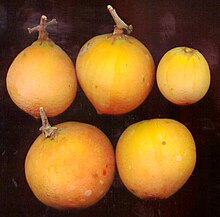| Ancylobothrys capensis | |
|---|---|

| |

| |
| Trailing down gorge in Magaliesberg | |
| Scientific classification | |
| Kingdom: | Plantae |
| Clade: | Tracheophytes |
| Clade: | Angiosperms |
| Clade: | Eudicots |
| Clade: | Asterids |
| Order: | Gentianales |
| Family: | Apocynaceae |
| Genus: | Ancylobothrys |
| Species: | A. capensis |
| Binomial name | |
| Ancylobothrys capensis (Oliv.) Pichon | |
| Synonyms | |
| |


Ancylobothrys capensis, the wild apricot, is a tangled, sprawling, multi-stemmed Southern African creeper of the family Apocynaceae.
It is evergreen, often scrambling over rocks and other plants. New growth is covered in velvety, reddish-brown hairs. When damaged it exudes copious amounts of white latex. The leathery leaves are broadly elliptic, simple, opposite and erect, with prominent venation on both surfaces. Flowers are fragrant, about 40mm diameter, brilliant white when open and pinkish in bud.
The round fruit are up to 50mm in diameter, khaki-green when immature, turning bright orange or yellow when ripe. The skin is thick, soft, brittle, and easily peeled. 3-4 seeds are embedded in a sweet and tasty acidic pulp.
The species is common and occurs in rocky areas, particularly on quartzites throughout KwaZulu-Natal, Mpumalanga, Gauteng, Limpopo Province, North West Province and Botswana.
References
- ^ "World Checklist of Selected Plant Families: Royal Botanic Gardens, Kew". apps.kew.org. Retrieved 2017-08-07.
- ^ "Ancylobothrys capensis". PlantZAfrica.com. Archived from the original on 14 January 2010. Retrieved 2010-02-10.
External links
- Dressler, S.; Schmidt, M. & Zizka, G. (2014). "Ancylobotrys capensis". African plants – a Photo Guide. Frankfurt/Main: Forschungsinstitut Senckenberg.
![]() Media related to Ancylobotrys capensis at Wikimedia Commons
Media related to Ancylobotrys capensis at Wikimedia Commons
| Taxon identifiers | |
|---|---|
| Ancylobothrys capensis | |
| Landolphia capensis | |